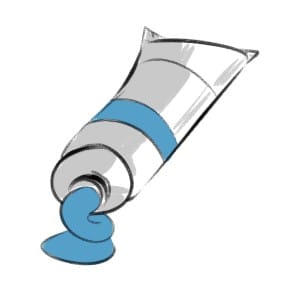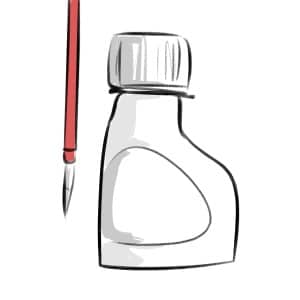Watercolor is a very fun medium and I can’t stress enough how much I love it. The thing that I like the most about it it’s how soft and fluid it looks.
It’s a very relaxing activity!
Either if you’re a complete beginner at this or if you already tried your hand at watercolors, I’ll leave here the best watercolor supplies to get started.

For drawing with watercolor, you need a few supplies, that’s why I recommend the following:
- Canson XL Series Watercolor Textured Paper Pad. For watercolors, you need thick paper. This way, your paper won’t shrivel as you add water to it!
- Crafts 4 ALL Watercolor Paint Set. You can find watercolor paint in different forms. Both dry and liquid. This one is the second option and it might be a bit easier to use at the beginning.
- Marrywindix Set of 9 Brushes. Most of the times, you’ll want to find pointy brushes like this ones when painting with watercolors. They’re very flexible and perfect for both small details and wider strokes.
- Ohuhu Water Coloring Brush Pens. These are definitely my favorite watercolor brushes! They are very easy to use, and you can just store the water inside the tube and regulate how much water you want.
- Darice 13-Inch-by-10-Inch Palette. This is always good to have, so you can mix up your paints however you want and take out the excess of water from your brush!
- Winsor & Newton Art Masking Fluid. The magic tool! If you want to leave white spaces in your watercolors, this is what you’re looking for.
- Adhesive Eraser: An adhesive eraser is very useful if you’re using a Masking Fluid.
I’ll talk about everything in more detail right below this list.
Best Paper for Watercolor
Canson XL Series Watercolor Textured Paper Pad
You need very specific paper for watercolors.
The thicker watercolor paper you can get, the better!
This Canson pad has about 300gsm and the perfect texture to paint with watercolors. If you read my post about cartridge paper, I do mention this matter over there as well!
If not, take a peak, so you can understand a bit better about paper weight and why it’s important.
Canson and other brands offer a wide variety of paper weights and for watercolors, you want something with 160 gsm and more.
This way, you can sketch softly and then paint it with watercolors!

I do recommend the 300gsm one since it is a very reliable paper. Its surface is very sturdy and thick, so you can use any wet medium on it and the paper won’t misbehave.
Using water won’t cause wrinkles in your paper, nor bleeds. So it’s a safe choice!
The pad is very comfortable to use. You can fold the cover so that it won’t be in your way.
Alternatively, you can always take individual sheets of paper from the pad and use them separately.
This pad has 30 sheets, each 9 x 12 inches. It’s quite a big canvas already, but even if you prefer to use something smaller, you can cut each sheet into smaller ones, and you’ll have paper for even longer!
The colors pop up a lot in this paper, and it makes them look vibrant.
Mix your colors and have all the fun! Alternatively, check out one of these sketchbooks instead of using a watercolor pad!
Best Paints for Watercolor
Crafts 4 ALL Watercolor Paint Set
This is a great set of quality paints for all skill levels, especially for beginners!
The reason for this being that it brings 24 tubes of different pigments (colors) and tones. This way, you don’t need to mix and match colors until you get the one you got, making things easier for you.

The second reason is that these come in tubes. Unlike most watercolors, that comes in dry cubes, and you use water to dissolve them. In this case, you can use them, such as they are, right out of the tube, but also add water if you wish to.
These are made to be as simple as possible to use and start with.
The colors from these tube paints are very vibrant, and they have a very smooth blending capacity. The pack also comes with two brushes, for you to try out and experiment with your watercolors right away!
Alternatively, you can get a half pan set, like these Winsor & Newton Watercolor Paint Sets!
The main difference when using a half pan watercolor set instead of a tube, is that they are more portable to use since they come into what looks like small cakes or tablets of paint.
They’re especially convenient for using in the outdoors, so consider getting one of these sets if you’re going to be drawing outside!
The biggest downside is that it’s harder to mix colors with a pan set.
Best Paint Brushes For Watercolors
Pointed brushes are my favorites to use with watercolors.
They are easy to control and are very good for detailed strokes. These paintbrushes also behave very well with water, making them very suitable for painting with watercolor.
This set comes with 9 different round brushes, which is more than enough and will suit your needs perfectly.
9 different brush sizes for you to try and figure out which is better for what and what do you prefer to use.

The brush hair is very flexible, and it won’t shed very easily.
These are made of nylon wool, not synthetic material or sable.
So you don’t need to be afraid of having loose brush hairs glued to your drawings, trying to ruin them! They are also easy to wash, just rinse them through water, and they’re good to go.
Having all these brushes with different sizes means that you can work with different sizes of canvas, switching between brushes depending on the size you’re working with.
Apart from watercolors, you can use these brushes with many other different mediums, including body paint, since the brush won’t harm your or a kid’s skin!
Although I always recommend having different brushes for different mediums, if you have no other choice, these will do well with anything!
The Best Pens for Watercolor
Ohuhu Water Coloring Brush Pens
I love, love, love these!
These brush pens are very good, especially if you like to draw outdoors or like to travel with your painting supplies. The holder serves for more than holding your brush.
It is actually a container, for you to add water to.
This means you don’t need to dip your brush your brush in a cup, over and over, trying to add more or less water to your paint and never getting the right amount.
It will also reduce the mess you’d usually do while going through this process.

Just press the container and the water will go into your brush and then you just need to start painting.
This makes it much easier to regulate the amount of water you want, but it’s also very practical to carry it around.
Just fill the container, put the brush in your purse, along with your sketchbook and watercolors case.
Whenever you’re hit by inspiration, you can sit down and start drawing.
This pack comes with 6 brushes, 3 with pointy tips and the other 3 are flat. Each set of three has different sizes, a small tip, a medium one and large.
They’re very easy to wash and won’t spray, spread or smear very easily.

Other than watercolor paint, you can use them with any water-soluble mediums, like markers and colored pencils.
They are definitely very practical and portable, a big favorite of mine!
Other Useful Tools
Other than the main tools you’ll need that we just went over, there are some secondary tools that, sooner or later, you might want to get for watercoloring.
None of these are overly expensive and will last you for quite some time.
Let’s go over them.
Painting Palette
Although not strictly necessary, a palette can be very useful for you to mix your colors and to regulate how much water you need. Like the Darice Palette.
This Darice Palette has different shapes and sizes to hold your paint.
You can use them to dip some paint on it, another to add water to, and another square to clean the excess paint from your brush.

The palette is made from plastic, so it’s very easy to wash.
Other than watercolor, you can also use it with different mediums, like acrylics and oil, if you wish to.
Art Masking Fluid
Even though this is not a must have when starting to learn watercolors, I definitely recommend getting some masking fluid at some point.
This is a very fun tool to use, as well as useful and practical.
I recommend the Winsor Newton Masking Fluid (check it out on Amazon).
If you want to leave white spots on your drawings, you just need to add this fluid in those spots. Let it dry for a bit, and now you can paint comfortably without fearing that some paint will get to the white spots.

When you’re finished, and your drawing is dry, just take the masking fluid out, and the white will pop up!
This is perfect for adding lights and shining to your drawings and makes it so much easier to do so.
Adhesive Eraser
If you have masking fluid, you’ll also need an adhesive eraser.
This adhesive eraser by XYRON does the job well!
Instead of cleaning up the masking fluid by hand, this eraser will take it out in seconds, without damaging your paper!

Although not strictly necessary, it does make your life easier, and it will remove any adhesive residue from paper faster!
Paper Towels
Paper towels can be quite useful when using watercolor supplies since you can use them to absorb excess water, create some texture, and even correct mistakes!
Not only that, but you can also clean your brushes so the colors don’t mix on them on accident.
Related Questions
Let’s quickly go over a few things that might be on your mind about all these watercolor supplies.
What Are The Different Types Of Watercolor Paper?
There are 3 different types of water color paper: cold press, hot press, and rough.
- Cold Press Paper has a slightly textured surface, which makes it very versatile and popular for a wide range of watercolor techniques!
- Hot Press Paper, on the other hand, has a quite smooth surface, which makes it perfect for detailed illustrations and smooth lines. It also affects how the colors blend, since they aren’t absorbed as quickly as with other paper.
- Rough Paper is, as the name suggests, a rough, textured surface! It can create some very expressive effects if used correctly and is very fun to experiment with.
That’s about it! Now get started with your watercolor art!
What Are The Best Watercolor Brands?
In general, the best watercolor brands are Winsor & Newton, Daniel Smith, Schmincke, Sennelier, and Holbein.
With that said, all of the brands I’ve mentioned in this article are great. Especially if you’re looking for watercolor supplies for beginners that won’t break the bank.
Your training as a watercolor artist is what’s important. Many artists start with basic, cheap supplies and get the more expensive ones much further in their careers.
How Do I Care For Watercolor Brushes So They Last Longer?
To care for watercolor brushes so they last a long time, rinse them very well after each use.
Don’t forget to gently reshape the bristles and allow them to dry completely on fresh air. You can also store your brushes with their top part up or just lying flat on a surface. This way, they can maintain their shape!
And don’t leave your watercolor brushes in water for a long time, this will damage the brushes.
For more art supplies, check out my article on the Best Art Supplies For Painting!



